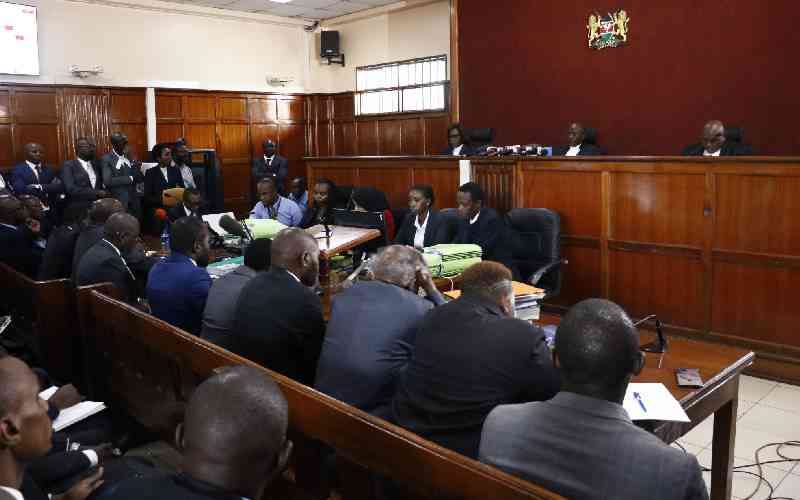 |
|
Women have also borne the brunt of the disease. |
By NYAMBEGA GISESA
Marsabit; Kenya: The three-year-old was born in good health. But now his belly is bigger than his head. He has huge bluish eyes that look like a bud of a flower, dying young.
His legs are feeble and arms twig-like. He cries endlessly on his mother’s arms inside a hut made of twigs and old torn pieces of sack with holes to let in light.
The child is suffering from a terminal disease that is devastating his community along with scores of others in parts of northern Kenya, where it has decimated the ranks of nomads. The same illness killed his aunties and grandmother and affects a number of his neighbours.
“He has a growing tumour in his stomach,” Asunta Galgille, a government nurse from Kargi Medical Dispensary, the only health facility in the area, tells us at the request of the boy’s mother, who is too distraught to talk to us.
“Patients like him don’t last.”
A few weeks after our visit, Asunta calls us.
“The child has died,” she says.
The child’s illness stands at the heart of a lethal mystery- and legacy of mischief and neglect by international firms and the government, which have resisted pleas for aggressive action to spotlight the malady and find a remedy.
The firms and the government are more focused on discovering oil deposits than ending the plight of the residents of the region where those valuable deposits have the potential of injecting several trillions of shillings to the economy.
Little noticed by the rest of the country, cancer is mowing down members of two of the Kenya’s poorest populations and minority communities, Rendille and Gabbra, along a stretch of hundreds of kilometres in northern Kenya located in Kenya’s largest county, Marsabit.
Its victims are nomads, mostly women who have never been into a classroom or visited a hospital.
Since 1989, when the first case was diagnosed in hospital, cancer has killed more than 500 people, according to health and church officials as well as village elders. One nurse has recorded about 100 deaths of the diagnosed cases. Since many nomads venture far from home in search of pasture and water, the number of those dying of the disease without visiting hospital is high. Their deaths are not recorded.
The most affected areas are Kargi, Maikona, Kalacha and Chalbi, where there are now more people dying from the ailment and symptoms associated with the disease than HIV/Aids, diarrhoea, typhoid, malaria and malnutrition combined.
“Every month we refer at least a patient who is eventually diagnosed with cancer,” says John Kodesa, a medic at Kargi Dispensary.
Stay informed. Subscribe to our newsletter
“These patients don’t survive.”
The scourge is overwhelming the local health facility, depleting health budgets, and leaving a trail of widowers, widows and orphans in the rural communities.
“We have been forced to add our supply of IV fluids,” Kodesa says. “When the referred patients are discharged, they are brought here to die. At least with the fluids we assist in prolonging their lives.”
So many people have died from the ailment that the community has termed the area as the Manyattas of Death.
At first glance, the area characterised by vast arid vegetation and tonnes of desert sands looks like many places in northern Kenya: bare-breasted women with jerricans travelling tens of kilometres in search of water, young children taking care of goats and sheep in the thorny bushes, morans with simis (swords) and clubs ready for a fight taking care of camels and old men with sticks converged in small groups trading gossip and news.
Years back, you would never have spotted a Rendille grave. “When our people die, we burry them far away in the bush because we don’t want to remember about them,” says Hiroya Orre, a university student and Marsabit County Miss Tourism contestant who was our guide.
But now there are burial grounds with the ailment not only taking away lives but also being responsible for traditional and cultural rites of the community.
“We know that our people have died from cancer. We want to talk about it and remember what killed them,” Wambile tells us.
Cancer is a multi-faceted disease known to be caused by both internal and external risk factors including tobacco, alcohol, numerous chemical substances, radiation, and some infectious organisms.
According to a policy brief on the situational analysis of cancer in Kenya dated 2011 prepared for the Parliamentary Departmental Committee on Health, statistics in Kenya has shown that about 50 Kenyans die daily from various forms of cancers. Cancer ranks third among the main causes of death in Kenya after infections and Cardiovascular or Heart related diseases.
At early stages, various forms of cancer can typically be managed.
In the villages of Kargi, Maikona, Kalachi and Chalbi, the disease’s origins are more of an enigma, and the parts it affects more frequently lethal.
Some scientists, health officials and locals suspect that exposure to an unknown toxin may have triggered onset of the disease. They suspect that oil companies out to explore oil in the area in the 1980s might have either used harmful chemicals during the exploration or dumped harmful waste in the area.
“When you excavate the ground you bring to the surface heavy metals in terms of rocks, and when those metals get in contact with water and the same is converted into a flood and gets in contact with water bodies, man will come into contact with the same,” said Dr Richard Oduor, a biochemist.
“Effects of radioactivity are very cumulative. It can take ages before ionisation occurs. With ionisation there is possibility of cell mutations,” Dr Oduor adds, saying that proper investigations have to be carried out in the area so as to establish whatever is behind the ailment.
The residents have either died from cancer of the oesophagus, throat, chin, liver, uterus, scalp, prostate gland, scalp, breast, back bone, lower limbs, mandible bones, stomach and brain. Most of those who have died from the disease are females aged between 40 and 60 years old.
From the records we have from one health facility, so far the three-year old boy is the youngest victim to fall to the ailment. The second youngest victim was 13-year-old Saboyo Silamo, a young girl who died from the cancer of the scalp in 2000. This does not include several unrecorded cases.
With the recording of the youngest cancer victim, the mystery persists: Why do these cancer cases affect mostly women aged between 40 to 60 years? Why are there about a dozen body parts affected by the cancer and why in this specific region?
Possible explanations that have been given include rampant use of tobacco, eating meat that is not inspected and use of relief food.
Unfit for consumption
A key contributing factor and potential culprit is: dumping of radio-active material. Residents also suspect that exposure to an unknown dumped chemicals and waste might have triggered onset of the disease.
In January 2000, all hell broke loose after 2,000 livestock died after consuming water from a borehole in Kargi. This forced the government to run into action.
When a District Inter-ministerial Team from Marsabit arrived at the area to investigate, they not only found a horrific scene of animals that had dropped dead but also a bizarre scene.
“The people were mourning the death of their animals and asking their god for answers,” David Wamile, a soft-spoken man who is the area’s chief recalls. “I have never seen such grief in my life.”
However, instead of burying the animals, they ate their meat. The Rendille are a community whose day starts after praying for their animals to find pasture and ends with prayers thanking their god for safely delivering the animals to the manyattas. A Veterinary Department investigation report over the incidence has never been released.
Years later in 2006, when cases of cancer hit an alarming level, it caught the attention of the local population. The government giving in to pressure appointed a team of experts and sent it to the region to investigate.
The team was concerned about the number of cancer cases and the growing suspicion surrounding the drinking water that residents had complained was not fit for human consumption especially during the rainy season. The team carried out tests on water and soil and carried out dozens of interviews.
Water samples were analysed both at the Department of Mines and Geology and at the Government Chemist while solid samples were sent to the Institute of Nuclear Science at the University of Nairobi.
An Environmental Impact Assessment (EIA) carried out by NEMA quotes an Amoco representative who is said to have told the communities that result from the University of Nairobi’s Institute of Nuclear Science showed that there were no nuclear or hazardous materials buried in the abandoned wells.
However, the results established the presence of bentonite and high levels of zinc and nitrates that is above the maximum permissible levels.
“The high level of nitrates can be attributed to the large amounts of animal waste that washes into the wells during rains,” the report reads.
“High nitrate levels in water are known to cause death in animals especially when they are feed on vegetation enriched in nitrates as a result of large amounts of livestock waste being deposited in grazing areas.”
Interestingly, the government report indicated that there was “no clear relationship between the presence of bentonite and baryte at the well sites and any contamination in the water in the borehole and in the shallow wells.
In 2009, Tecnoedil, an Italian firm contracted by the Marsabit Catholic Diocese, carried out a water quality analysis of Kargi. A similar study was done in July 2007 by Bill Philips of Williams Consulting Incorporation for the firm Global Concern.
The Global Concern action to assess the levels of arsenic in water on the health status of the local community and a NEMA report did not establish a problem for the high number of livestock deaths and cancer cases. However, they concluded that the water was not fit for human consumption.
— [email protected]
 The Standard Group Plc is a
multi-media organization with investments in media platforms spanning newspaper
print operations, television, radio broadcasting, digital and online services. The
Standard Group is recognized as a leading multi-media house in Kenya with a key
influence in matters of national and international interest.
The Standard Group Plc is a
multi-media organization with investments in media platforms spanning newspaper
print operations, television, radio broadcasting, digital and online services. The
Standard Group is recognized as a leading multi-media house in Kenya with a key
influence in matters of national and international interest.
 The Standard Group Plc is a
multi-media organization with investments in media platforms spanning newspaper
print operations, television, radio broadcasting, digital and online services. The
Standard Group is recognized as a leading multi-media house in Kenya with a key
influence in matters of national and international interest.
The Standard Group Plc is a
multi-media organization with investments in media platforms spanning newspaper
print operations, television, radio broadcasting, digital and online services. The
Standard Group is recognized as a leading multi-media house in Kenya with a key
influence in matters of national and international interest.






